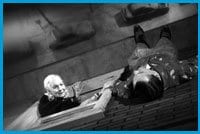The shame. Me, arts editor of the country’s largest gay paper, a Winnipegger and historian to boot, out artied, out gayed, even out mother-fixated by straight director Guy Maddin and his historical fantasia My Winnipeg that premiered at the Toronto International Film Festival (TIFF) last week.
Despite its profoundly personal perspective, My Winnipeg felt like my Winnipeg. Never has a film so beautifully mapped out my emotional heritage.
All the familiar Winnipeg touchstones are here: the rivers, the cold, the trains, the blindness toward Natives and Native history, the General Strike of 1919, the bombed-out streetscapes grinning like a drunkard’s gap-toothed smile, the rape of the Jets hockey team and above all the nostalgia — all refracted through Maddin’s fevered imagination.
Told through a shimmering amalgam of archival material, home movies, mini-melodramas, back projections, historical recreations, shadow puppetry, even dance, and narrated by Maddin himself, My Winnipeg is a hilarious movie, equal parts history, biography, poetry and downright fabrication. In scenes dramatizing family stories, Maddin pretends to cast his own mother as his mother (she’s played by Ann Savage of the 1945 film noir classic Detour); it’s a good-humored, loving game of retribution played against a tough, feisty old broad.
But the laughs give way to tears when toward the end of this expertly paced 80 minutes, a reunion scene of sorts occurs between mother and a long-dead son. Heart-wrenching.
This might be Maddin’s best film yet.
The Winnipeg-based filmmaker has always had the honesty and insight to acknowledge same-sex attraction and desire, and here he serves up a smorgasbord of male delights and terrors, from the “dance of the hairless boners” by an intimidating gang of boys at a public pool and Russian hockey hunks in the Winnipeg Arena showers to gay bison. Maddin, however, won the “honourary gay” sobriquet oft-used in this paper not by his choice of subject matter (Sissy Boy Slap Party notwithstanding) but by his perverse sense of humour — a constant use of camp as a crucial way, if not the only way, to experience reality. Life is a palimpsest, Maddin’s films assert, and surface layers and outward reality deserve to be mocked. Truth lies somewhere beneath, with subterranean desires and misunderstood needs, with shame and regret.
My Winnipeg is a form of psychological archaeology, where Maddin unearths a strange litany of objects, personal totems with mystical powers: river forks, laps, arteries, mother, keys, urine, helmets, white block house….
You need not be gay, Winnipegish or even arty to relate to My Winnipeg; its themes of desire and grief are universal. This requiem for a city that might have been is in fact a love letter to his family: a dead father, a dead brother, an aging mother.
Everything we love dies. We can’t escape our hometowns of sleepwalkers, of ghosts. That’s a reality no one wants to face. But like many good artists and drag queens, Maddin knows there’s hope, a truth beyond reality, where fantasies come true and what we love lives forever. As he states in My Winnipeg: “Maybe I can film my way out, make my own ‘Happyland.'”
I can’t think of a better justification for a festival like TIFF than showcasing Maddin’s passionate dream reality of Canada.


 Why you can trust Xtra
Why you can trust Xtra


